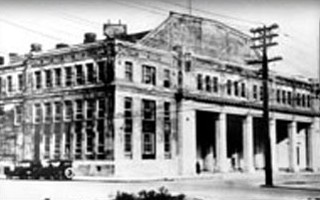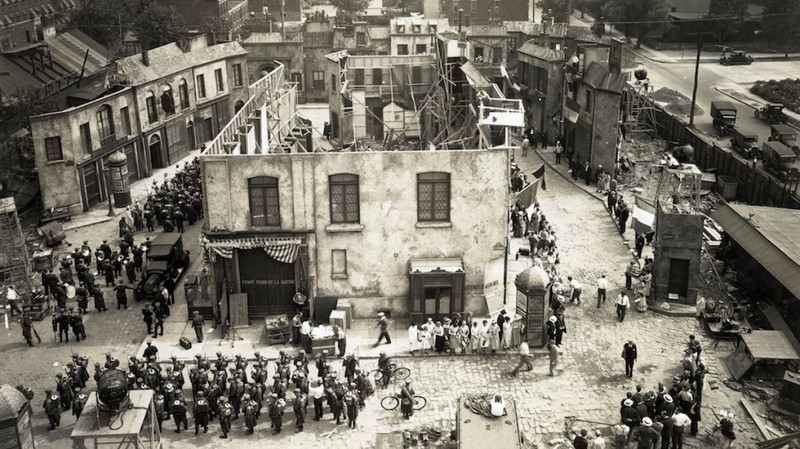Kaufman Astoria Studios
Introduction
Text-to-speech Audio
Kaufman Astoria Studios was opened in 1920 as the production facilities of Paramount Pictures on the East Coast. It was opened by Adolph Zukor, the film director who started Paramount Studios. The Army Pictorial Center took over the facilities at the beginning of World War II, and they used it to produce training videos, along with other military-related footage. After the Army Pictorial Studios left, the building was taken over by the Federal Government who kept control until giving the title to the City of New York in 1982. In 1982, George Kaufman, a real estate developer, was put in charge of renovating and expanding the complex. The project was completed by Kaufman, and today, the studio is used for producing both small and big-budget projects. It was placed on the National Register of Historic Places in 1978.
Images
Old Picture of the Studio

1929 Musical "The Battle of Paris"

Backstory and Context
Text-to-speech Audio
Kaufman Astoria Studios is a movie production facility located in Astoria, New York. The Studio was opened in 1920 by Adolph Zukor, a famous early film producer, for the Famous Players Film Company. Eventually, Famous Players became Paramount Pictures, and Zukor served as the president of Paramount Pictures until 1936. During its early years, the Studio was the center of the film community in New York, producing over 100 films during the 1920s and '30s. With more and more films being produced, Astoria Studios attracted talented actresses and actors to star in its productions, including Rudolph Valentino and the Gish Sisters.
By the end of the 1930s, most movie productions moved West to California as Hollywood became the center of the film world. In 1942, with fewer movies being produced in New York, Kaufman Astoria Studios was taken over by the United States Army Signal Corps Army Pictorial Service at the start of World War II. The Army used the facilities to produce training and other instructional videos for military use, which they continued to do after the War. The Army Signal Corps stopped production at the Studio in 1970.
The Federal Government took control of the property in 1970 after the Army classified it as "surplus property." Under the Federal Government's control, the Studio was used for the production of Thieves (1975) and The Next Man (1976). It was also leased out several times. The City of New York gained the title of the property from the Federal Government in 1982.
After the City of New York took control, the property was leased to George Kaufman, a real estate developer. The Studio was renovated under Kaufman, with additional buildings added to the facility as well. Since then, Kaufman Astoria Studios has once again become a center of the film community in New York City, producing films like The Wiz, Hair, Glengarry Glen Ross, and Carlito's Way.
By the end of the 1930s, most movie productions moved West to California as Hollywood became the center of the film world. In 1942, with fewer movies being produced in New York, Kaufman Astoria Studios was taken over by the United States Army Signal Corps Army Pictorial Service at the start of World War II. The Army used the facilities to produce training and other instructional videos for military use, which they continued to do after the War. The Army Signal Corps stopped production at the Studio in 1970.
The Federal Government took control of the property in 1970 after the Army classified it as "surplus property." Under the Federal Government's control, the Studio was used for the production of Thieves (1975) and The Next Man (1976). It was also leased out several times. The City of New York gained the title of the property from the Federal Government in 1982.
After the City of New York took control, the property was leased to George Kaufman, a real estate developer. The Studio was renovated under Kaufman, with additional buildings added to the facility as well. Since then, Kaufman Astoria Studios has once again become a center of the film community in New York City, producing films like The Wiz, Hair, Glengarry Glen Ross, and Carlito's Way.
Sources
"Astoria's History." Central Astoria. Accessed Web, 11/17/17. https://www.centralastoria.nyc/neighborhood%20information/astoria-history.
"The Film Industry in Astoria." The Story of Astoria. Accessed Web, 11/17/17. https://macaulay.cuny.edu/seminars/rosenberg09/articles/t/h/e/The_Film_Industry_in_Astoria_9fd9.html.
"Our Legacy." Kaufman Astoria Studios. Accessed Web, 11/17/17. http://www.kaufmanastoria.com/our-legacy/.
Reysen, Jamie. "Secrets of Kaufman Astoria Studios." AM New York. 1/13/16. Accessed Web, 11/17/17. https://www.amny.com/secrets-of-new-york/secrets-of-kaufman-astoria-studios-1.11310255.
"The Film Industry in Astoria." The Story of Astoria. Accessed Web, 11/17/17. https://macaulay.cuny.edu/seminars/rosenberg09/articles/t/h/e/The_Film_Industry_in_Astoria_9fd9.html.
"Our Legacy." Kaufman Astoria Studios. Accessed Web, 11/17/17. http://www.kaufmanastoria.com/our-legacy/.
Reysen, Jamie. "Secrets of Kaufman Astoria Studios." AM New York. 1/13/16. Accessed Web, 11/17/17. https://www.amny.com/secrets-of-new-york/secrets-of-kaufman-astoria-studios-1.11310255.
